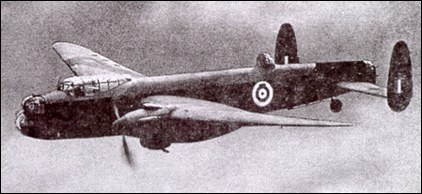|
| The Manchester was a twin-engined, medium-range bomber. First flown in prototype form in July 1939 with twin fins and rudders and new 24-cylinder X-type Rolls-Royce Vulture engines. A central fin was added during flight trials. Maximum bomb load was 5,080kg. Defensive armament comprised 7.62mm machine-guns in nose, rear and mid-upper rotating turrets. Production aircraft were built by Avro (156 Mk I) and Metropolitan-Vickers (44).
The bomber first entered service in November 1940 with No 207 Squadron, RAF, and carried out its first operational mission to Brest during the night of 24-25 February 1941. The triple fin arrangement was later deleted and enlarged end-plate fins and rudders were fitted to a longer tailplane (Manchester Mk IA). Unfortunately the Vulture engine proved unreliable and the Manchester's operational life ended on 25 June 1942 with a raid on Bremen. A four-engined development of the Manchester became the Lancaster.
FACTS AND FIGURES © The Vulture engines produced
much less power than anticipated
and were prone to various failures © Armament was eight machine
guns, four of them in the rear
turret. The bomb load was
1814kg less than that of
the standard Lancaster. © To give adequate stability with
one engine out, the Manchester I
had a central fin as well as two
endplate fins. This was replaced
on the Mk Ia with two larger end
fins and a wider railplane. © Longer wings, larger tail surfac
and four powerful and reliable
Merlin engines cured all the
Manchester's ills and created the
famous Lancaster. © Rows of small windows were a
particular Manchester feature,
although they were found on the
first Lancasters, which were
converted from Manchester on
the production line.

| CREW | 7 |
| ENGINE | 4 x Rolls-Royce "Vulture", 1312kW |
| WEIGHTS |
| Take-off weight | 25401 kg | 56000 lb |
| Empty weight | 13350 kg | 29432 lb |
| DIMENSIONS |
| Wingspan | 27.46 m | 90 ft 1 in |
| Length | 21.13 m | 69 ft 4 in |
| Height | 5.94 m | 20 ft 6 in |
| Wing area | 105.63 m2 | 1136.99 sq ft |
| PERFORMANCE |
| Max. speed | 426 km/h | 265 mph |
| Cruise speed | 298 km/h | 185 mph |
| Ceiling | 5850 m | 19200 ft |
| Range | 2623 km | 1630 miles |
| ARMAMENT | 8 x 7.7mm machine-guns, 4700kg of bombs |
 | A three-view drawing (952 x 1201) |
| Klaatu83, e-mail, 13.10.2015 16:04 "It deserves to be called the British He-177 and it's engines the British DB-606" That's a very appropriate comparison. As with the DB-606, the R-R "Vulture" engine was created by combining two V-12 engines on a single drive shaft to make an "X-24". Both the German and British engines had many problems, and neither ever worked out as well as expected. However, the British had the good sense to replace the two unsatisfactory "Vulture" engines in the Manchester with four very satisfactory "Merlin" engines to create the Lancaster, while the Germans persisted with the unsatisfactory DB-606.
Incidentally, the Hawker was also planning to use the "Vulture" engine in a fighter, which was to be called the "Tornado". Just as with the Manchester, however, that project was dropped and the aircraft became successful with a different engine, becoming known as the "Typhoon". reply | | BHH, 27.08.2013 11:37 @dwaite A great bomber sure, but not better than the B-29. reply | | Ruben de Jong, e-mail, 19.08.2013 19:05 replace the bad engines by Twin Wasps and you got the perfect medium bomber! i would call it " Lilicaster" reply |
| bombardier, e-mail, 25.05.2011 11:57 It deserves to be called the British He-177 and it's engines the British DB-606 reply | |
| | dwaite, e-mail, 17.01.2011 21:40 take away two vulture engines & add four merlin engines & Uget the best heavy bomber of ww2 the AVRO LANCASTER better by far than any yank heavy bomber reply | | paul, e-mail, 12.08.2010 23:19 My uncle was shot down flying a manchester bomber in the second world war he was flying over Essen reply | | Chris, e-mail, 22.02.2010 19:26 I agree that the engines were not the best course of action
also the colant pipes were not ataquitlly armord causing engine overheat. reply | | APJones, e-mail, 03.02.2010 18:59 Silly me the plane in Cosford air museum is an AVRO Lincoln , similar loking but came into service at the end of the WW" not at the beginning like the Manchester reply |
| APJones, e-mail, 01.02.2010 18:51 There is a Manchester in RAF Cosford air museum (well worth going to - FREE entrance )
I was priveleged to sit in the pilots seat, would not like to have got out the plane in a hurry with a parachute on ! reply | | Graham Barnard, e-mail, 14.11.2009 23:48 Hi, An old friend of mine flew the Manchester bomber crashing in Norway at the beginning of WW11 He talked about reverse propellors, can you help me on that topic?
Thanks Graham Barnard reply | | stuart renshaw, e-mail, 13.05.2008 16:39 could you tell me there are any manchester bombers still flying as i was at my mums in romiley stockport on sat the 10 /05 /08 when an old bomber flew over but i couldnt quite make out what it was it looked like a manchester as it only had two engines could anyone help me reply | | EMBER, e-mail, 23.12.2007 00:35 THE 'VULTURE' ENGINES WERE PROBABLY THE MOST DISSASTEROUS ENGINES THAT COULD HAVE BEEN INSTALED. UNDER-POWERED, PRON TO CUTTING OUT, AND OFTEN GIVING THE AIRCRAFT UNWANTED YAW, THE COMPANY WAS FORCED TO TRY NEW OUT FITTINGS AND ,IN THE END' BUILD ANOTHER AIRCRAFT ALL TOGETHER. reply |
|
Do you have any comments?
|
| 
COMPANY
PROFILE
All the World's Rotorcraft
|








 APJones
APJones
20
reply